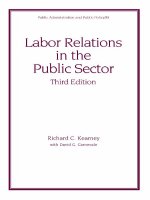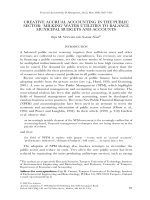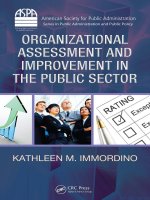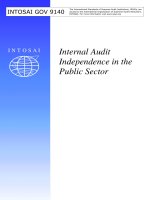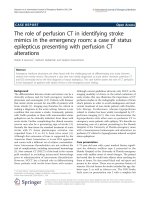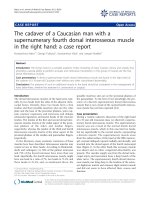An Appraisal Of Accounting System In The Public Sector (A Case Study Of Board Of Internal Revenue Enugu State)
Bạn đang xem bản rút gọn của tài liệu. Xem và tải ngay bản đầy đủ của tài liệu tại đây (183.98 KB, 95 trang )
AN APPRAISAL OF ACCOUNTING SYSTEM IN THE PUBLIC
SECTOR
(A CASE STUDY OF BOARD OF INTERNAL REVENUE ENUGU
STATE)
BY
NNAMANI UGOCHUKWU J.C.
ACC/2006/241
DEPARTMENT OF ACCOUNTNACY
FACULTY OF MANAGEMENT AND SOCIAL SCIENCE
CARITAS UNIVERSITY
AMORJI NIKE
ENUGU STATE
JULY, 2010.
An Appraisal of Accounting System
In the public Sector
(A case study of board of Internal Revenue Enugu State)
By
Nnamani Ugochukwu J.c.
Acc/2006/241
Department of Accountancy
Faculty of Management & Social Science
Caritas University
Amorji – Nike,Enugu.
Submitted to
Department of Accountancy Caritas University
In partial fulfillment of Degree of the Requirement for the award of the
Bachelor of Science (B.Sc) in Accounting
July, 2010.
CERTIFICATION
This is to certify that this work was submitted by Nnamani
Ugochukwu J.C. ACC/2006/241 of the Department of Accountancy, Caritas
university, Amorji nike, Enugu, Enugu State in partial fulfillment of the
requirement for the award of a B.Sc in Accountancy.
------------------------Mr. Agu C.I.
Supervisor
--------------Date
------------------------Mr. Ugwu C.C.
Head of Department
Accountancy
--------------Date
------------------------External Supervisor
--------------Date
DEDICATION
This project work is dedicated to the king of kings who made it
possible for me to reach this stage in life, for his mercies, love, protection
and guidance throughout the completion of my program and to my lovely
parent Mr. and Mrs. Sunday Okechukwu Fredrick Nnamani (J.P.) for their
untiring efforts towards my academic pursuit.
ACKNOWLEDGEMENT
My utmost gratitude goes to God almighty, who has made this
academic feat possible. My beloved parent Mr. and Mrs. Suday Okechukwu
Nnamani (J.P) deserve every commendation for their efforts in giving me
proper orientation; for their understanding, encouragement, and for that most
valuable financial support and unending prayers. My beloved siblings
Ndidiamaka, Ezinne and Chinecherem Nnamani, they were always
encouraging and praying for me. I also extend my unalloyed gratitude to all
who has in one way or the other contributed towards the actualization of this
dream. Worthy of mention include: Barr. And Mrs. SAN Chukwuani, Mr.
and Mrs.Davidson Ownmi and also Mr. and Mrs. Andy Egbo (National) for
their contribution and love shown to me during the course of this work and
also has been one of the brain behind my achievement. I am equally grateful
to my project supervisor Mr. Agu C.I. for his patience, prompt attention,
suggestion, strict and careful scrutiny of this work. I shall not fail to
acknowledge the role of all the lecturers in department of accountancy
especially my H.O.D Mr. Collins Ugwu, Mr. P.U. Nsoke, Mr. Frank Ovute
and Chinedu Enekwe for their time, academic encouragement, training and
assistance. Finally, my appreciation goes to Obiora Onyiorah, Ugwuanyi
Emmanuel, Ohanwe Emeka, Chisom Mbata, Anya, Chioma Ani, Chinelo,
C.Y., G. Money, Keke-money, Fabian, Pamela, Ekwe, Chika (MVB),
Nnamdi Ukeje, ATM money (Course Rep.), Adaobi, Chika Agu Loveth,
phnatex, Lorita, Chineye Ochili and Onyi Madubuko for their support, love,
and care throughout my stay in school.
ABSTRACT
This write up is the result of a studying of the accounting process in
the public sector. The work is principally aimed at providing an insight into
the accounting system of Board of Internal revenue Enugu State, its
inefficience, problems and ways these problems could be effectively be
managed. This work is divided into five chapters namely; The first chapter
which is the introduction of the topic, the researcher defined public sector
accounting, the purpose and objective as well as the significance of the
study. In chapter two, the researcher focuses on the review of related
literature as it is related to the research topic and such review include
historical development of government accounting, Basis of accounting and
sources of cash and recording media. In chapter three, the researcher
indicated the research method used in detail; also it was in chapter four that
the data used were collected, presented, analyzed and show the responses to
the area being investigated which were documented along with their
percentage relating to the question asked. In the last chapter, the researcher
discussed the result obtained from data analysis in chapter four and also a
useful and constructive suggestion was put down as that any interested party
may be wee guided.
TABLE OF CONTENTS
Cover page:......................................................................
Title page:…………………………………………………………..
Certification:………………………………………………………
Dedication:………………………………………………………..
Acknowledgement:………………………………………………
Abstract:………………………………………………………….
Table of contents:………………………………………………
CHAPTER ONE: INTRODUCTION
1.1
Background of the study:…………………………….
1.2
Statement of the Problem:……………………………
1.3
Objective of the study:………………………………..
1.4
Significance of the study:……………………………
1.5
Research question:……………………………………
1.6
Scope and Limitation of the study:……………….
1.7
Definition of terms:…………………………………..
CHAPTER TWO: REVIEW OF LITERATURE
2.1
Introduction:………………………………………….
2.2
Historical Development of Government Accounting:
2.3
Financial Information:……………………………………
2.4
Sources of cash and Recording Media:………….
2.5
Nature and purpose of Government Accounting:..
2.6
Fund Accounting classification:…………………
2.7
Basis of Accounting:………………………………….
2.8
Depreciation:……………………………………………
CHAPTER THREE: RESEARCH METHODOLOGY AND DESIGN
3.1
Research design ………………………………………..
3.2
Sources of data ………………………………………….
3.3
Population of the study ………………………………..
3.4
Determination of sample size and techniques…….
3.5
Method of data collection ……………………………..
3.6
Procedure of data analysis ……………………………
CHAPTER FOUR: DATA PRESENTATION AND ANALYSIS
4.1
Section A (Personal Data)……………………………..
4.2
Section B (Cash)…………………………………………
4.3
Section C (Cheque)……………………………………...
4.4
Section D (Stocks/Supplies) ………………………….
CHAPTER FIVE: SUMMARY OF FINDINGS, CONCLUSION
AND RECOMMENDATIONS
5.1
Summary of findings …………………………………………..
5.2
Conclusion ……………………………………………………….
5.3
Recommendation ………………………………………………
References
Bibliography
Appendix
CHAPTER ONE
INTRODUCTION
1.1
BACKGROUND OF THE STUDY
History has it that the concept of accountability of public funds dates
backs to the history of ancient Greece. As old as theory is, it would not be
erroneous to say that the idea has been equally lost to antiquity although not
much is known about it, this makes the subject, government accounting to
remain a myth.
Accounting in the public sector has received such a wide attention
from scholars that the field of public sector accounting scans to be neglected.
However, there is general awareness all over the world of the need to
pay greater attention to the development of government accounting and
financial control. The reason is obvious, government, in most, if not all
nations constitute the largest single business entity in many places, the core
of the economy. Government in any society is basically for maintaining law
and order. With changes and the complete nature of the society, government
responsibility has automatically changed from the role of maintaining law
and order to business like nature in the modern era. The enormous activities
of government, equally call for enlarged government accounting in order to
accommodate the immense task.
As a result of this development, the
traditional cash procedures of accounting can hardly meet the demands of
reasonable accounting for modern government in providing necessary
services or information. Therefore, there is need for government accounting
to be dynamic in order to accommodate both the fundamental roles and the
developments.
Government accounting is the process of recording, analyzing,
classifying, summarizing, communicating and interpreting financial
information about government in aggregate and in detail, reflecting all
transactions involving the receipts, transfer and disposition of government
funds and property.
The purpose are to demonstrate the propriety of
transactions and their conformity with established rules to give evidence of
accountability for the stewardship of government resources and to provide
useful information for the good control and efficient management of
government operation.
Financial management in the public services as can be observed has
failed to encourage and promote the efficient utilization of public funds or
serve as effective basis for planning and decision making as well as to
ensure proper accountability.
Besides, it does not mean that financial
irregularities being detected in public sector at large is basically based on
traditional cash procedure of accounting but it does arouse a question
whether the modern system of accounting will make both modern
management and financial management viable.
STATEMENT OF THE PROBLEM
The problem of this research is to identify these weaknesses and
limitations inherent in the cash accounting system of the public sector (in
relation to the accounting system of the sample ministry).
This is with a view to propose means of eliminating them completely
or at least reducing them to the barest minimum. Put in question form, what
are those weaknesses and limitation that militates against adequate and
efficient accounting system and financial reporting in the public sector and
how can they be eliminated?
Some of these problem witnessed in the public sector includes: the
lack of accountability and abuse of delegated authority by the officers in
authority, fraud and misappropriation of government funds, as well as lack
of expertise and business acumen on the part of those officers. Due to the
fact that government operation have been termed “Non-profit oriented
operations”, there is no pressure on the part of these government officers to
perform up to optimum expectation, accounts are kept in messy shape while
the officers get away with lack of proper accountability.
This research is carried out in order to examine the extent to which
proper accounts are being kept in the public sector and to offer solution to
the inherent problem discovered.
The Enugu State Ministry of Finance and Economic Development is used as
a sample ministry for this research work.
OBJECTIVES OF THE STUDY
The objectives of this research work/study include the following:
-
To determine the extent to which the sample Ministry has installed
an accounting system.
-
To determine the factors that promote or constrain the accounting
system of the sample ministry.
-
To determine the impact of the accounting procedures of the
sample ministry upon its financial reporting.
-
To make recommendations based on my findings.
IMPORTANCE OF THE STUDY
This research paper is intended to examine the accounting system
common in public sector with a view to exposing and highlighting the
inherent limitations in the system. Therefore, the research paper will be of
interest and useful to the general publics, the government as well as the
governed.
Government entrust public funds in the hands of its officials hence
government reporting has traditionally stressed stewardship.
Original
accounting emphasis has been directed towards measuring the public funds
generated and expended by the government’s programme or activities. The
traditional reporting approach is filled with many weaknesses of which it is
hoped that this study will make useful recommendation on how to improve
upon the accountability and financial reporting system of the government.
The duty to report all its financial activities to the general public is a
debt that government must pay. Such report will enable the people know
how public funds entrusted in the hands of the government have been
utilized, this type of report is very sensitive and useful to the public but very
few of them (the public) can understand it. This study will serve as a useful
medium to such member of the public who find government financial
reporting very ambiguous and hard to understand.
In many institution of higher learning the accounting curriculum
offered is tailored specifically to provide students with an understanding of
financial reporting as it relates to profit oriented enterprises.
For this
purpose, students are frequently surprised to discover that the basic
framework of financial accounting is significantly altered when the profit
motive is removed. Though the accounting terminology may initially appear
to resemble foreign language to all students of accountancy, and related
professions who always depraved of knowledge of accounting system of the
public sector, this study will be very useful.
Moreover, potential researcher in this aspect of accounting will find
this research paper a very reliable reference base.
RESEARCH QUESTIONS
Three dominant questions being reviewed by this research include;
-
Is the accountancy/accounting system in the public sector effective
and adequate?
-
Does the accounting system in the public sector provide for proper
financial control and accountability of stewardship?
-
Does the accounting system in the public sector provide useful
information for the effective control and management of
government operations?
SCOPE AND LIMITATION OF THE STUDY
As the research topic would suggest at a glance, the scope of this, is
essentially focused on the accounting system of the sample ministry as a
general overview sample study of the accounting in the public sector.
Therefore, this study will look into the nature of the accounting
system of the sample ministry; how the system operates, the relevance of the
system to the environment, problems and prospects of the system.
LIMITATION
-
Scarcity of material:
This aspect of accountancy (as pointed out above) has received very
little attention from scholars despite its long historical age. Consequently,
there are few literary publication on the student; the researcher was therefore
limited to reviewing few literature which are mostly in origin, through
relevant to the study.
-
Bureaucracy:
Government establishment are well known for maintaining utmost
screening as regards their operations, more so, where it is a study that
concerns their financial operation the researcher found it difficult to obtain
material relating to the study (that is literature) and some officials who have
been very elusive and uncooperative. More so the bureaucracy and protocol
the research went through to obtain material and an appointment has been
very discouraging.
Due to all this constrains, the researcher cannot say for certain
whether the study has covered very rutty gritty of the sample ministry as
regards its accounting systems and procedures, but one thing is certain,
enough materials have been gathered to help express an opinion as to the
operative of the sample ministry.
Apart from the above listed limitations witnessed by this researcher is
time constraint. This is a major limiting factor as the time between approval
of the study and the deadline for submission was very short. The researcher
relied heavily on the good will of the research supervisor because he
understands my plight.
Again lack of sufficient funds to conduct an
extensive study was another handicap.
This was part of the reason why I had to limit my work to fewer staffs
than was earlier planned.
DEFINITION OF TERMS
Every field, discipline or profession has its terminology.
Therefore, government accounting can never be an exception. In order to
ensure easy understanding by the users of this work in relation to
government accounting which are extensively applicable in public sector and
or which have different meaning from private sector interpretation and usage
are here by define below:
(1)
Accounting Entity: Clearly defined economic unit which (a) Engages
in identifiable economic activities
(b) Controls economic resources (for which accounting records are
maintained and periodic financial statement is prepared.
(c) is distinct from the personal dealings of its owners or employees. To
ensure that the fundamental accounting equation always refers to the same
distinct entity the boundaries of the unit, once established, must not be
managed arbitrarily also called reporting entity.
Accounting entity is in the accounting and auditing, banking,
commerce and finance and corporate, commercial and general law subjects.
Accounting entity appears in the definition of the following terms;
accounting change, reporting entity, combination, fund and accounting
policies.
(2)
Accrual Accounts: The principles of “accruals” makes a distinction
between the receipt of cash and the right to receive it, and the payment of
cash and the liability to pay it, stressing the importance of the right to the
assets or the legal obligation in favour of the movement of the cash.
(3)
Annual Appropriations:
These are issues required to meet the
expenditure of the state other than those covered by direct issues from the
consolidated Revenue Fund.
(4)
Capital: Is a plan of action quantified usually in monetary units to
serve as a guild for the achievement of government objectives.
(5)
Cash accounting; the recording of the transaction in which revenue
and expense are reported (cash inflow and outflow) in the period in which
the related cash receipts and payment occur. The wide spread use of cash
accounting in public sector results from the government’s historically based
requirement for financial information that shows fiscal compliance.
(6)
Capital Budget:
This is the budget that sets out the proposed
acquisition of fixed (long-term) assets or projects and their finance.
(7)
Depreciation: A non cash expense that reduces the value of an asset
as a result of wear and tear, age, or obsolescence. Most assets lose their
value over time (in other words, the depreciated), and must be replaced once
the end of their useful life is reached. There are several accounting methods
that are used in order to write off an asset’s depreciation cost over the period
of its useful life. Because it is a non-cash expense depreciation lowers the
company’s reported earning while increase free cash flow.
Although,
government accounting does not recognize depreciation and this is one of
the criticisms of the system.
(8)
Encumbrance:
Is an expense, which
is both contingent and
estimated. Obligations in the form of purchase order, contact or salary
commitments which are chargeable to an appropriation and for which a part
of the appropriation is reserved.
These obligations cease to be
encumbrances when paid or when paid or when the actual liability is
recorded. This term has no equivalent in the private sector accounting since
unperformed portions of executing contracts are not recognized in the
accounts.
(9)
Estimated Revenue (Budget): If the accounts are kept on the accrual
basis, this term designates the amount of revenue estimated to accrue during
a given period regardless of whether or not it is all to be collected during the
period.
(10) Expenditure (Actual Expenses): this is expenditure chargeable to an
appropriation.
(11) Fixed Assets: A long – term, tangible assets held for business use and
not expected to be converted to cash in the current or upcoming fiscal year,
such as manufacturing equipment, real estate, and furniture (also called
plant)
(12) Functional Budget/Programme Budget: A budget that allocates costs
(or inputs) to particular functions or activities.
(13) Fun Accounting: This is basically operated on cash basis. It is an
accounting arrangement whereby self-balancing set of accounts are provided
for specific purpose. This system of accounting is usually used by nonprofit organization and by the public sector.
(14) Fund balance; the excess of assets of a fund over its liabilities are
reserves, except in the case of funds subject to budgetary accounting where
prior to the end of a fiscal period. It thus represents the excess of the fund’s
assets and revenues for the period over its liabilities reserves, and
appropriations for the period.
(15) Historical cost Accounting; the traditional system of accounting that is
based on valuations made in terms of the price ruling when transactions take
place. In practice, this is modified by the concept of prudence and the
possible revaluation of fixed assets.
(16) Revenue (Actual Revenue): is that revenue which are recorded on
accrual basis, this term designates additions to assets which:
-
Do not represent the recovery of the expenditure
-
Do not represent the cancellation of certain liabilities without a
corresponding increase in other liabilities or decrease in assets.
(17) Warrant: Authority for expenditure from the consolidated Revenue
fund covered by the appropriation law in respect of recurrent budget or from
the capital development fund is the case of a capital budget.
CHAPTER TWO
REVIEW OF RELATED LITERATURE
INTRODUCTION
Originally there were distinguishing features that differentiate
government accounting and commercial accounting. But in the new era,
there is little or no different because most government units are now
engaging in the profit making ventures, while some commercial enterprises
also engage in non-profit ventures.
The two main differences usually pointed out are:
1.
The absence of a profit motive in government and;
2.
That managers in government primarily aim at conforming to
legislative” (Anthony 1980. Pg 83 – 93).
However, the profit making motive of the government is only
applicable to a very few areas, while the commercial sectors profit is on the
basis of yearly activities.
According to Premchand (1983. P.380) “There is no (and there cannot
be any) equivalent of profit in the government though the concern of
government and the commercial world are the same all over in regard to the
allocation and use of resources both material”2. Whether in the public sector
or in the private is for “measurement and communication and to provide
economic and social information about an identifiable entity to permit users
to make judgment and decision….”3
Landgendefer (1973, pg. 50).
By and large, government accounting is
supposed to feed two groups of users; the government and the general
public.
HISTORICAL
DEVELOPMENT
OF
GOVERNMENT
ACCOUNTING
The growth of government accounting can be traced to the period
before and during the middle ages when local officials had to lender
accounts for receipt and payment or expenses to their master, the king or the
royal auditor. The ruin of the royal finances and the chaotic state of account
in France in the eighteenth century was one of the causes of the French
revolution which promulgated the doctrine of popular sovereignty over
public finance so that tax could be levied without the assent of the nation.
The separation of law making function of government and the executive
power in the French constitution during the time of Montesquieu rendered
the existing accounting system disproportionate and the executive had to
request and to render account to the legislature.
Similar condition prevailed in Great Britain, which called for high
degree accountability with respect to public funds.
There was a long
historical tussle in Britain for parliamentary control of funds with respect to
control over taxation. The consolidated fund Act of 1787 provided a single
general form for expenditures.
There was thus laid basis for the
comprehensive financial statement of operation and stewardship of public
funds.
In United States of America since 1789, the secretary of treasury has
been required to prepare and report upon estimates of public revenue and
expenditures. The budget later became a mechanism whereby the president
submits his programmes to the congress and this resulted in an effective
means through which (the president) could be hold responsible. The United
States of American Budget Accountancy act of 1921 formed the basis for a
responsible and responsive government, which provided the necessary
framework with respect to government funds. Historically, the accounting


